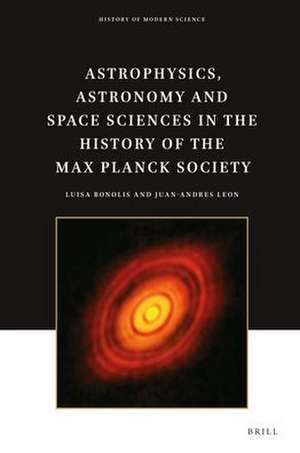Astrophysics, Astronomy and Space Sciences in the History of the Max Planck Society: History of Modern Science, cartea 4
Autor Luisa Bonolis, Juan-Andres Leonen Limba Engleză Hardback – 7 dec 2022
Preț: 827.63 lei
Preț vechi: 1009.30 lei
-18% Nou
Puncte Express: 1241
Preț estimativ în valută:
158.42€ • 172.13$ • 133.16£
158.42€ • 172.13$ • 133.16£
Carte indisponibilă temporar
Doresc să fiu notificat când acest titlu va fi disponibil:
Se trimite...
Preluare comenzi: 021 569.72.76
Specificații
ISBN-13: 9789004449756
ISBN-10: 9004449752
Pagini: 678
Dimensiuni: 155 x 235 mm
Greutate: 0 kg
Editura: Brill
Colecția Brill
Seria History of Modern Science
ISBN-10: 9004449752
Pagini: 678
Dimensiuni: 155 x 235 mm
Greutate: 0 kg
Editura: Brill
Colecția Brill
Seria History of Modern Science
Notă biografică
Luisa Bonolis, M.A. in Physics, Sapienza University of Rome and Ph.D. in History of Science, University of Bari, is a scholar at the Max Planck Institute for the History of Science, Berlin. She has published monographs and articles on the history of twentieth-century physics.
Juan-Andres Leon,, M.A. in Physics and B.A in History from Universidad de los Andes, and Ph.D. in the History of Science from Harvard University. He has been a postdoctoral researcher at the Science History Institute in Philadelphia and at the Max Planck Institute for the History of Science in Berlin. He is currently a Curator at the Science Museum in London.
Juan-Andres Leon,, M.A. in Physics and B.A in History from Universidad de los Andes, and Ph.D. in the History of Science from Harvard University. He has been a postdoctoral researcher at the Science History Institute in Philadelphia and at the Max Planck Institute for the History of Science in Berlin. He is currently a Curator at the Science Museum in London.
Cuprins
Contents
Foreword by Reinhard Genzel
Foreword by Jürgen Renn
Acknowledgments
Oral History Interviews
List of Illustrations and Figures
Acronyms and Abbreviations
Introduction
1 Nuclear Age (1945–1957): Reconstruction under Regional Fragmentation
1 Postwar Scientific Traditions in Göttingen
2 Postwar Research Traditions in Southwest Germany
3 The Orphan Scenario: Regener, Kiepenheuer, and Dieminger
4 Regional Alliances and Rivalries
2 Space Age (1957–1980s): A Unique Opportunity for Expansion
1 ‘Sputnik Shocks’
2 Reorientation of the Max Planck Society in the Early Space Age: Complementarity and Uncoordinated Competition
3 Astronomical Revolution in the MPG (1960s–1980s): Completing the Wavelength Spectrum
1 Ground-Based Astronomy
2 High-Energy Space-Based Astronomy
3 Reconfiguration of the Astrophysical Sciences and Institutes
4 Internationalization (1970s Onwards): Infrastructural Disappointments and the New International Division of Labor
1 From National Infrastructures to International Collaborations
2 Historical Change and Resilience in Times of Hardship at the End of the Century
3 Into the 21st Century: A New Role for the Max Planck Institute for Astrophysics
5 Global Leadership in Emerging Fields: Toward Astro-Particle Physics, Relativistic Astrophysics, and Multi-Messenger Astronomy
1 Three Case Studies
2 The Solar Neutrino Puzzle: Heidelberg between Cosmochemistry and Astroparticle Physics
3 The Quest for Gravitational Waves
4 From Cosmic Rays to Ground-Based Gamma Ray Astronomy
Appendix: The History of Cosmic Research in the Max Planck Society through Its Finances
1 A Complementary Analysis
2 Financial Periodization of the Cosmic Sciences in the Max Planck Society
3 Shifting Balances of ‘Nuclear,’ ‘Cosmic,’ and ‘Earth-System’ Research
4 Financial Lock-Ins and the Complementarity of Theoretical and Experimental Research
5 Astronomical Institutes, Their Infrastructures, and the End of an Era for the MPG
Bibliography
Index
Foreword by Reinhard Genzel
Foreword by Jürgen Renn
Acknowledgments
Oral History Interviews
List of Illustrations and Figures
Acronyms and Abbreviations
Introduction
1 Nuclear Age (1945–1957): Reconstruction under Regional Fragmentation
1 Postwar Scientific Traditions in Göttingen
2 Postwar Research Traditions in Southwest Germany
3 The Orphan Scenario: Regener, Kiepenheuer, and Dieminger
4 Regional Alliances and Rivalries
2 Space Age (1957–1980s): A Unique Opportunity for Expansion
1 ‘Sputnik Shocks’
2 Reorientation of the Max Planck Society in the Early Space Age: Complementarity and Uncoordinated Competition
3 Astronomical Revolution in the MPG (1960s–1980s): Completing the Wavelength Spectrum
1 Ground-Based Astronomy
2 High-Energy Space-Based Astronomy
3 Reconfiguration of the Astrophysical Sciences and Institutes
4 Internationalization (1970s Onwards): Infrastructural Disappointments and the New International Division of Labor
1 From National Infrastructures to International Collaborations
2 Historical Change and Resilience in Times of Hardship at the End of the Century
3 Into the 21st Century: A New Role for the Max Planck Institute for Astrophysics
5 Global Leadership in Emerging Fields: Toward Astro-Particle Physics, Relativistic Astrophysics, and Multi-Messenger Astronomy
1 Three Case Studies
2 The Solar Neutrino Puzzle: Heidelberg between Cosmochemistry and Astroparticle Physics
3 The Quest for Gravitational Waves
4 From Cosmic Rays to Ground-Based Gamma Ray Astronomy
Appendix: The History of Cosmic Research in the Max Planck Society through Its Finances
1 A Complementary Analysis
2 Financial Periodization of the Cosmic Sciences in the Max Planck Society
3 Shifting Balances of ‘Nuclear,’ ‘Cosmic,’ and ‘Earth-System’ Research
4 Financial Lock-Ins and the Complementarity of Theoretical and Experimental Research
5 Astronomical Institutes, Their Infrastructures, and the End of an Era for the MPG
Bibliography
Index



